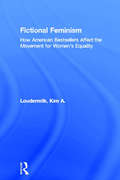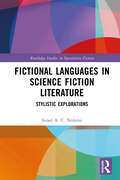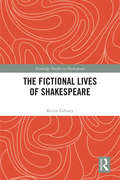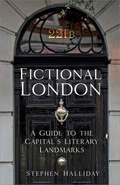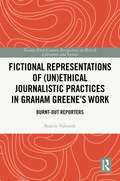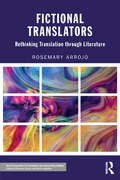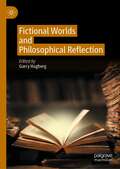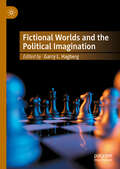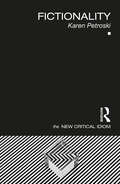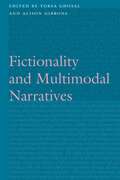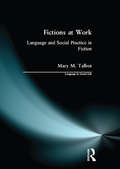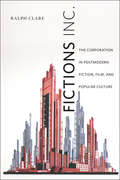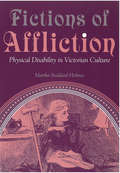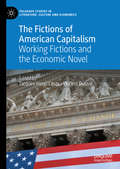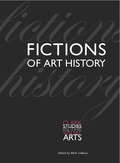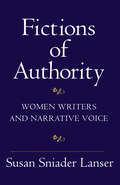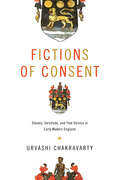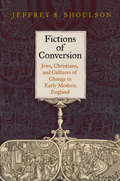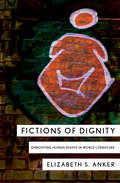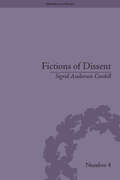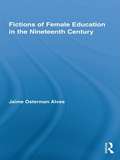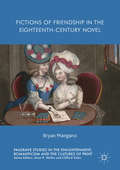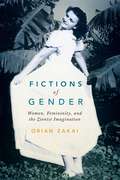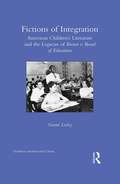- Table View
- List View
Fictional Feminism: How American Bestsellers Affect the Movement for Women's Equality (Literary Criticism and Cultural Theory)
by Kim A. LoudermilkThis book focuses on the ways in which second-wave feminism has been represented in American popular culture, and on the effects that these representations have had on feminism as a political movement. Kim Loudermilk provides close readings of four best-selling novels and their film adaptations. According to Loudermilk, each of these novels contains explicitly feminist characters and themes, yet each presents a curiously ambivalent picture of feminism; these texts at once take feminism seriously and subtly undercut its most central tenets. This book argues that these texts create a kind of "fictional feminism" that recuperates feminism's radical potential, thereby lessening the threat it presents to the status quo.
Fictional Languages in Science Fiction Literature: Stylistic Explorations (Routledge Studies in Speculative Fiction)
by Israel A. NolettoFictional Languages in Science Fiction Literature surveys a large number of fictional languages, those created as part of a literary world, to present a multifaceted account of the literary phenomenon of glossopoesis (language invention). Consisting of a few untranslated sentences, exotic names, or even fully-fledged languages with detailed grammar and vocabulary, fictional languages have been a common element of English-language fiction since Thomas More’s Utopia (1516).Different notions of the functions of such fictional languages in narrative have been proposed: as rooted in phonaesthetics and contextual features, or as being used for characterisation and construction of alterity. Framed within stylistics and informed by narrative theory, literary theory, literary pragmatics, and semiotics, this study combines previous typologies into a new 5-part reading model comprising unique analytical approaches tailored to science fiction’s specific discourse and style, exploring the relationship between glossopoesis, world-building, storytelling, interpretation, and rhetoric, both in prose and paratexts.
The Fictional Lives of Shakespeare (Routledge Studies in Shakespeare)
by Kevin GilvaryModern biographies of William Shakespeare abound; however, close scrutiny of the surviving records clearly show that there is insufficient material for a cradle to grave account of his life, that most of what is written about him cannot be verified from primary sources, and that Shakespearean biography did not attain scholarly or academic respectability until long after Samuel Schoenbaum published William Shakespeare A Documentary Life in 1975. This study begins with a short survey of the history and practice of biography and then surveys the very limited biographical material for Shakespeare. Although Shakespeare gradually attained the status as a national hero during the seventeenth and eighteenth centuries, there were no serious attempts to reconstruct his life. Any attempt at an account of his life or personality amounts, however, merely to "biografiction". Modern biographers differ sharply on Shakespeare’s apparent relationships with Southampton and with Jonson, which merely underlines the fact that the documentary record has to be greatly expanded through contextual description and speculation in order to appear like a Life of Shakespeare.
Fictional London: A Guide to the Capital’s Literary Landmarks
by Stephen Halliday‘By seeing London, I have seen as much of life as the world can show.’ - Samuel JohnsonFrom Chaucer’s pilgrims meeting in a Southwark inn to the Hogwarts Express leaving from King’s Cross, London has always been a popular place for writers to weave into their own work. With its bustling, multicultural population and unique localised weather, the city is almost a character in its own right. Fictional London explores the capital through the eyes of both the reader and the writer. Celebrated London historian Stephen Halliday traces the stories from one end of London to the other, digging into the history and character that has made it an unrivalled source of inspiration for authors and poets from the Middle Ages to the early 2000s and beyond.
Fictional Representations of: Burnt-Out Reporters (21st Century Perspectives on British Literature and Society)
by Beatriz ValverdeBritish author Graham Greene pursued a professional career as a journalist before becoming a full-time writer. After that, he continued taking on reporting assignments as a correspondent for a variety of publications. Greene knew the profession inside out, and the role of the media in shaping the public’s views through information gathering and dissemination—a topic insufficiently researched by criticism—was among his main concerns. Greene’s fictional work features an array of journalists, and the representation of (un)ethical practices of the profession is a constant reference in his narrative. In this book, I intend to fill this research gap in Greenean studies, focusing on three main topics: the author’s reflection on the journalistic practice in connection with the classic paradigm of objectivity versus empathy; his questioning of the misuse of power when gathering and disseminating information by journalists, editors and news corporation owners; and finally, the relationship between journalists and their readership’s expectations, as well as the importance of fostering critical readers that make informed trustworthy decisions regarding journalism performance.
Fictional Translators: Rethinking Translation through Literature (New Perspectives in Translation and Interpreting Studies)
by Rosemary ArrojoThrough close readings of select stories and novels by well-known writers from different literary traditions, Fictional Translators invites readers to rethink the main clichés associated with translations. Rosemary Arrojo shines a light on the transformative character of the translator’s role and the relationships that can be established between originals and their reproductions, building her arguments on the basis of texts such as the following: Cortázar’s "Letter to a Young Lady in Paris" Walsh’s "Footnote" Wilde’s The Picture of Dorian Gray and Poe’s "The Oval Portrait" Borges’s "Pierre Menard, Author of the Quixote," "Funes, His Memory," and "Death and the Compass" Kafka’s "The Burrow" and Kosztolányi’s Kornél Esti Saramago’s The History of the Siege of Lisbon and Babel’s "Guy de Maupassant" Scliar’s "Footnotes" and Calvino’s If on a Winter’s Night a Traveler Cervantes’s Don Quixote Fictional Translators provides stimulating material for reflection not only on the processes associated with translation as an activity that inevitably transforms meaning, but, also, on the common prejudices that have underestimated its productive role in the shaping of identities. This book is key reading for students and researchers of literary translation, comparative literature and translation theory.
Fictional Worlds and Philosophical Reflection
by Garry HagbergThis edited collection investigates the kinds of philosophical reflection we can undertake in the imaginative worlds of literature. Opening with a look into the relations between philosophical thought and literary interpretation, the volume proceeds through absorbing discussions of the ways we can see life through the lens of literature, the relations between philosophical saying and literary showing, and some ways we can see the literary past philosophically and assess its significance for the present. Taken as a whole, the volume shows how imagined contexts can be a source of knowledge, a source of conceptual clarification, and a source of insight and understanding. And because philosophical thinking is undertaken, after all, in words, a heightened sensitivity to the precise employments of our words – particularly philosophically central words such as truth, reality, perception, knowledge, selfhood, illusion, understanding, falsehood – can bring a clarity and a refreshed sense of the life that our words take on in fully-described contexts of usage. And in these imagined contexts we can also see more acutely and deeply into the meaning of words about words – metaphor and figurative tropes, verbal coherence, intelligibility, implication, sense, and indeed the word “meaning” itself. Moving from a philosophical issue into a literary world in which the central concepts of that issue are in play can thus enrich our comprehension of those concepts and, in the strongest cases, substantively change the way we see them. With a combination of conceptual acuity and literary sensitivity, this volume maps out some of the territory that philosophical reflection and literary engagement share.
Fictional Worlds and the Political Imagination
by Garry L. HagbergThere has been a steady stream of articles written on the relations between political thought and the interpretation of literature, but there remains a need for a book that both introduces and significantly contributes to the field – particularly one that shows in detail how we can think more freely and creatively about political possibilities by reading and reflecting on politically significant literature. This volume offers analytically acute and culturally rich ways of understanding how it is that we can productively think philosophically about political literature and what kind of distinctive conceptual progress we can make by doing so. Given the extremely widespread interest in political issues, this volume will strike resonant chords far and wide, while offering something that has not been done quite in this way and for which the time certainly seems right.
Fictionality (The New Critical Idiom)
by Karen PetroskiDoes fiction enhance reality, or threaten our sense of what is real? What, if anything, is special about experiencing fictional works and worlds? Today we speak casually of parallel universes and virtual reality; how much do we really know about what these phenomena involve? In Fictionality, Karen Petroski explains how philosophers and literary theorists have approached these questions in the Western literary tradition, from Greek antiquity to the present day. The book introduces readers to both long-running and contemporary debates about: • The value and dangers of engagement with fiction; • The origins of fictional artworks, especially literary works, in Western literature; • The role played by imagination in engaging with fiction; • The peculiarities of fictional "worlds"; • The structure of linguistic reference within fictional artworks; • The functions of fictionality in non-linguistic artworks such as film and television; • The role played by fictionality outside artworks, for example, in philosophy, law, and politics. Fictionality offers an accessible and comprehensive introduction to this field of increasing critical and theoretical interest. Bringing together theoretical insights from a variety of perspectives, it will be an essential resource for anyone studying fictionality.
Fictionality and Multimodal Narratives (Frontiers of Narrative)
by Torsa Ghosal Alison GibbonsFictionality and Multimodal Narratives interrogates the multimodal relationship between fictionality and factuality. The contemporary discussion about fictionality coincides with an increase in anxiety regarding the categories of fact and fiction in popular culture and global media. Today&’s media-saturated historical moment and political climate give a sense of urgency to the concept of fictionality, distinct from fiction, specifically in relation to modes and media of discourse. Torsa Ghosal and Alison Gibbons explicitly interrogate the relationship of fictionality with multimodal strategies of narrative construction in the present media ecology. Contributors consider the ways narrative structures, their reception, and their theoretical frameworks in narratology are influenced and changed by media composition—particularly new media. By accounting for the relationship of multimodal composition with the ontological complexity of narrative worlds, Fictionality and Multimodal Narratives fills a critical gap in contemporary narratology—the discipline that has, to date, contributed most to the conceptualization of fictionality.
Fictions at Work: Language and Social Practice in Fiction (Language In Social Life)
by Mary M. TalbotIn this book, Mary Talbot shows how fiction works in the constitution and reproduction of social life. She discusses both `high' and `low' fiction, combining discussion of social context with language analysis. Examples are taken from children's tales, romance, horror and science in her language analysis.
Fictions Inc.
by Ralph ClareFictions Inc. explores how depictions of the corporation in American literature, film, and popular culture have changed over time. Beginning with perhaps the most famous depiction of a corporation--Frank Norris's The Octopus--Ralph Clare traces this figure as it shifts from monster to man, from force to "individual," and from American industry to multinational "Other. " Clare examines a variety of texts that span the second half of the twentieth century and beyond, including novels by Thomas Pynchon, William Gaddis, Don DeLillo, Richard Powers, and Joshua Ferris; films such as Network, Ghostbusters, Gung Ho, Office Space, and Michael Clayton; and assorted artifacts of contemporary media such as television's The Office and the comic strips Life Is Hell and Dilbert. Paying particular attention to the rise of neoliberalism, the emergence of biopolitics, and the legal status of "corporate bodies," Fictions Inc. shows that representations of corporations have come to serve, whether directly or indirectly, as symbols for larger economic concerns often too vast or complex to comprehend. Whether demonized or lionized, the corporation embodies American anxieties about these current conditions and ongoing fears about the viability of a capitalist system.
Fictions of Affliction
by Martha Stoddard Holmes"Highly recommended . . . Holmes moves seamlessly from novelists like Charles Dickens to sociologists like Henry Mayhew to autobiographers like John Kitto. " ---Choice "An absolutely stunning book that will make a significant contribution to both Victorian literary studies and disability studies. " ---Rosemarie Garland-Thomson, Emory University "Establishes that Victorian melodrama informs many of our contemporary notions of disability . . . We have inherited from the Victorians not pandemic disability, but rather the complex of sympathy and fear. " ---Victorian Studies Tiny Tim, Clym Yeobright, Long John Silver---what underlies nineteenth-century British literature's fixation with disability? Melodramatic representations of disability pervaded not only novels, but also doctors' treatises on blindness, educators' arguments for "special" education, and even the writing of disabled people themselves. Drawing on extensive primary research, Martha Stoddard Holmes introduces readers to popular literary and dramatic works that explored culturally risky questions like "can disabled men work?" and "should disabled women have babies?" and makes connections between literary plots and medical, social, and educational debates of the day. Martha Stoddard Holmes is Associate Professor of Literature and Writing Studies at California State University, San Marcos.
Fictions of America: Narratives of Global Empire
by Judie NewmanThe Internet has had a huge impact on channels of communication and information, reaching across time and space to connect the world through globalisation. In this Internet-led world, story links to story, windows open on new stories and no overall authority establishes priority. This sense of globalisation has raised many questions for contemporary American Novelists, primarily the usefulness or redundancy of narrative and its potentially adaptive function. What are the right stories for such a broadband world? How do contemporary American novelists respond to issues such as the influence of the multinational corporation and its predecessors, human rights Imperialism, the literary work as a marketable commodity, translation as betrayal, data overload, and the implosion of the virtual into the biosphere? Is globalisation inevitable – or is it a fiction which fiction turns into reality? Fictions of America explores these questions and looks at the ways in which India, China and Africa can be said to have underwritten American culture, how literature has been marketed globally, and how novelists have answered back to power with resistant fictions. Judie Newman examines a wide range of fiction from the mid nineteenth to the twenty-first century including the transnational adoption narrative, short story, historical novel, slave narrative, international bestseller and Western to illustrate her argument. Looking closely at authors such as Bharati Mukherjee, John Updike, Emily Prager, Hannah Crafts, Zora Neale Hurston, David Bradley, Peter Høeg, and Cormac McCarthy, Fictions of America provides a bold response to the crucial questions raised by globalisation.
The Fictions of American Capitalism: Working Fictions and the Economic Novel (Palgrave Studies in Literature, Culture and Economics)
by Jacques-Henri Coste Vincent DussolThe Fictions of American Capitalism: Working Fictions and the Economic Novel introduces a new way of thinking about fiction in connection with capitalism, especially American capitalism. These essays demonstrate how fiction fulfills a major function of the American capitalist engine, presenting various formulations of American capitalism from the perspective of economists, social scientists, and literary critics. Focusing on three narratives—fictitious capital, working fictions, and the economic novel—the volume questions whether these three types of fiction can be linked under the sign of capitalism. This collection seeks to illustrate the American economy’s dependence on fictitiousness, America’s ideological fictions, and the nation’s creative literary fiction. In relation to what the credit and banking crisis of 2007–2008 exposed about the “unreal” base of the economy, the volume concludes with a call to recognize the economic humanities, arguing that American fiction and American literary studies can provide a useful mirror for economists.
Fictions of Art History
by Joanna Scott Alexander Nemerov Marianna Torgovnick Cole Swensen Marina Warner Caroline Vout Michael Hatt Paul Barolsky Gloria Kury Maria H. Loh Ralph Lieberman Mark Ledbury Thomas CrowFictions of Art History, the most recent addition to the Clark Studies in the Visual Arts series, addresses art history's complex relationships with fiction, poetry, and creative writing. Inspired by a 2010 conference, the volume examines art historians' viewing practices and modes of writing. How, the contributors ask, are we to unravel the supposed facts of history from the fictions constructed in works of art? How do art historians employ or resist devices of fiction, and what are the effects of those choices on the reader? In styles by turns witty, elliptical, and plain-speaking, the essays in Fictions of Art History are fascinating and provocative critical interventions in art history.
Fictions of Authority: Women Writers and Narrative Voice
by Susan Sniader LanserDrawing on narratological and feminist theory, Susan Sniader Lanser explores patterns of narration in a wide range of novels by women of England, France, and the United States from the 1740s to the present. She sheds light on the history of "voice" as a narrative strategy and as a means of attaining social power. She considers the dynamics in personal voice in authors such as Mary Shelley, Charlotte Brontë, Zora Neale Hurston, and Jamaica Kincaid. In writers who attempt a "communal voice"—including Mary Wollstonecraft, Elizabeth Gaskell, Joan Chase, and Monique Wittig—she finds innovative strategies that challenge the conventions of Western narrative.
Fictions of Consent: Slavery, Servitude, and Free Service in Early Modern England (RaceB4Race: Critical Race Studies of the Premodern)
by Urvashi ChakravartyIn Fictions of Consent Urvashi Chakravarty excavates the ideologies of slavery that took root in early modern England in the period that preceded the development of an organized trade in enslaved persons.Despite the persistent fiction that England was innocent of racialized slavery, Chakravarty argues that we must hold early modern England—and its narratives of exceptional and essential freedom—to account for the frameworks of slavery that it paradoxically but strategically engendered. Slavery was not a foreign or faraway phenomenon, she demonstrates; rather, the ideologies of slavery were seeded in the quotidian spaces of English life and in the everyday contexts of England's service society, from the family to the household, in the theater and, especially, the grammar school classroom, where the legacies of classical slavery and race were inherited and negotiated. The English conscripted the Roman freedman's figurative "stain of slavery" to register an immutable sign of bondage and to secure slavery to epidermal difference, even as early modern frameworks of "volitional service" provided the strategies for later fictions of "happy slavery" in the Atlantic world. Early modern texts presage the heritability of slavery in early America, reveal the embeddedness of slavery within the family, and illuminate the ways in which bloodlines of descent underwrite the racialized futures of enslavement.Fictions of Consent intervenes in a number of areas including early modern literary and cultural studies, premodern critical race studies, the reception of classical antiquity, and the histories of law, education, and labor to uncover the conceptual genealogies of slavery and servitude and to reveal the everyday sites where the foundations of racialized slavery were laid. Although early modern England claimed to have "too pure an Air for Slaves to breathe in," Chakravarty reveals slavery was a quintessentially English phenomenon.
Fictions of Conversion
by Jeffrey S. ShoulsonThe fraught history of England's Long Reformation is a convoluted if familiar story: in the space of twenty-five years, England changed religious identity three times. In 1534 England broke from the papacy with the Act of Supremacy that made Henry VIII head of the church; nineteen years later the act was overturned by his daughter Mary, only to be reinstated at the ascension of her half-sister Elizabeth. Buffeted by political and confessional cross-currents, the English discovered that conversion was by no means a finite, discrete process. In Fictions of Conversion, Jeffrey S. Shoulson argues that the vagaries of religious conversion were more readily negotiated when they were projected onto an alien identity--one of which the potential for transformation offered both promise and peril but which could be kept distinct from the emerging identity of Englishness: the Jew.Early modern Englishmen and -women would have recognized an uncannily familiar religious chameleon in the figure of the Jewish converso, whose economic, social, and political circumstances required religious conversion, conformity, or counterfeiting. Shoulson explores this distinctly English interest in the Jews who had been exiled from their midst nearly three hundred years earlier, contending that while Jews held out the tantalizing possibility of redemption through conversion, the trajectory of falling in and out of divine favor could be seen to anticipate the more recent trajectory of England's uncertain path of reformation. In translations such as the King James Bible and Chapman's Homer, dramas by Marlowe, Shakespeare, and Jonson, and poetry by Donne, Vaughan, and Milton, conversion appears as a cypher for and catalyst of other transformations--translation, alchemy, and the suspect religious enthusiasm of the convert--that preoccupy early modern English cultures of change.
Fictions of Dignity: Embodying Human Rights in World Literature
by Elizabeth S. AnkerOver the past fifty years, debates about human rights have assumed an increasingly prominent place in postcolonial literature and theory. Writers from Salman Rushdie to Nawal El Saadawi have used the novel to explore both the possibilities and challenges of enacting and protecting human rights, particularly in the Global South. In Fictions of Dignity, Elizabeth S. Anker shows how the dual enabling fictions of human dignity and bodily integrity contribute to an anxiety about the body that helps to explain many of the contemporary and historical failures of human rights, revealing why and how lives are excluded from human rights protections along the lines of race, gender, class, disability, and species membership. In the process, Anker examines the vital work performed by a particular kind of narrative imagination in fostering respect for human rights. Drawing on phenomenology, Anker suggests how an embodied politics of reading might restore a vital fleshiness to the overly abstract, decorporealized subject of liberal rights.Each of the novels Anker examines approaches human rights in terms of limits and paradoxes. Rushdie's Midnight's Children addresses the obstacles to incorporating rights into a formerly colonized nation's legal culture. El Saadawi's Woman at Point Zero takes up controversies over women's freedoms in Islamic society. In Disgrace, J. M. Coetzee considers the disappointments of post-apartheid reconciliation in South Africa. And in The God of Small Things, Arundhati Roy confronts an array of human rights abuses widespread in contemporary India. Each of these literary case studies further demonstrates the relevance of embodiment to both comprehending and redressing the failures of human rights, even while those narratives refuse simplistic ideals or solutions.
Fictions of Dissent: Reclaiming Authority in Transatlantic Women's Writing of the Late Nineteenth Century (Gender and Genre #4)
by Sigrid Anderson CordellFin-de-siècle fiction by British female aesthetes and American women regionalists stages moments of rebellion when female characters rise up and insist on the right to maintain control of their creations. Cordell asserts that these revolutionary acts constitute a transatlantic conversation about aesthetic practice and creative ownership.
Fictions of Female Education in the Nineteenth Century (Studies in American Popular History and Culture)
by Jaime Osterman AlvesSeeking to understand how literary texts both shaped and reflected the century's debates over adolescent female education, this book examines fictional works and historical documents featuring descriptions of girls' formal educational experiences between the 1810s and the 1890s. Alves argues that the emergence of schoolgirl culture in nineteenth-century America presented significant challenges to subsequent constructions of normative femininity. The trope of the adolescent schoolgirl was a carrier of shifting cultural anxieties about how formal education would disrupt the customary maid-wife-mother cycle and turn young females off to prevailing gender roles. By tracing the figure of the schoolgirl at crossroads between educational and other institutions - in texts written by and about girls from a variety of racial, ethnic, and class backgrounds - this book transcends the limitations of "separate spheres" inquiry and enriches our understanding of how girls negotiated complex gender roles in the nineteenth century.
Fictions of Friendship in the Eighteenth-Century Novel
by Bryan ManganoThis book explores the reciprocal influence of friendship ideals and narrative forms in eighteenth-century British fiction. It examines how various novelists, from Samuel Richardson to Mary Shelley, drew upon classical and early modern conceptions of true amity as a model of collaborative pedagogy. Analyzing authors, their professional circumstances, and their audiences, the study shows how the rhetoric of friendship became a means of paying deference to the increasing power of readerships, while it also served as a semi-covert means to persuade resistant readers and confront aesthetic and moral debates head on. The study contributes to an understanding of gender roles in the early history of the novel by disclosing the constant interplay between male and female models of amity. It demonstrates that this gendered dialogue shaped the way novelists imagined character interiority, reconciled with the commercial aspects of writing, and engaged mixed-sex audiences.
Fictions of Gender: Women, Femininity, and the Zionist Imagination (McGill-Queen’s Azrieli Institute of Israel Studies Series #1)
by Orian ZakaiIn the wake of the #MeToo movement, gender scholars and activists have asked whether a reconcilliation between Zionism and feminism is possible in the current political landscape. Fictions of Gender explores the contemporary controversies surrounding both Zionism and feminism, and how they are prefigured in the experiences and legacies of early Zionist women.Drawing on extensive archival research and the rarely studied corpus of published and unpublished creative, biographic, and essayistic writings by Zionist women throughout the intense first eighty years of the Zionist project (1880s–1950s), Orian Zakai situates Zionist women within the larger histories of colonization and the politics of ethnicity in Israel/Palestine. At the core of this study lie contemporary debates about the relationship between feminism, nationalism, and colonialism. Shifting long-standing paradigms in the scholarship on modern Hebrew literature and culture, Zakai confronts the study of gender and Zionism with the critical sensibilities of contemporary global feminism. Read both critically and compassionately, the writings of women authors and activists not only reveal lives full of contradictions but also point to cultural structures that shape the politics of Israel/Palestine to this very day.Fictions of Gender rethinks Israeli feminism through the lens of contemporary feminism, intersectionality, and post-colonialism.
Fictions of Integration: American Children's Literature and the Legacies of Brown v. Board of Education (Children's Literature and Culture)
by Naomi LesleyThis book examines how children’s and young adult literature addresses and interrogates the legacies of American school desegregation. Such literature narrates not only the famous battles to implement desegregation in the South, in places like Little Rock, Arkansas, but also more insidious and less visible legacies, such as re-segregation within schools through the mechanism of disability diagnosis. Novelizations of children’s experiences with school desegregation comment upon the politics of getting African-American children access to white schools; but more than this, as school stories, they also comment upon how structural racism operates in the classroom and mutates, over the course of decades, through the pedagogical practices depicted in literature for young readers. Lesley combines approaches from critical race theory, disability studies, and educational philosophy in order to investigate how the educational market simultaneously constrains how racism in schools can be presented to young readers and also provides channels for radical critiques of pedagogy and visions of alternative systems. The volume examines a range of titles, from novels that directly engage the Brown v. Board of Education decision, such as Sharon Draper’s Fire From the Rock and Dorothy Sterling’s Mary Jane, to novels that engage less obvious legacies of desegregation, such as Cynthia Voigt’s Dicey’s Song, Sharon Flake’s Pinned, Virginia Hamilton’s The Planet of Junior Brown, and Louis Sachar’s Holes. This book will be of interest to scholars of American studies, children’s literature, and educational philosophy and history.
